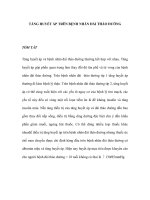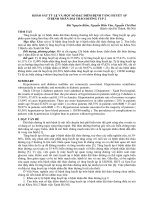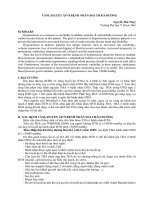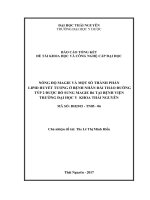Bài giảng Cập nhật chẩn đoán và điều trị tăng huyết áp ở bệnh nhân đái tháo đường - PGS.TS. Hoàng Anh Tiến
Bạn đang xem bản rút gọn của tài liệu. Xem và tải ngay bản đầy đủ của tài liệu tại đây (1.1 MB, 29 trang )
CẬP NHẬT CHẨN ĐOÁN VÀ
ĐIỀU TRỊ TĂNG HUYẾT ÁP
Ở BỆNH NHÂN ĐÁI THÁO ĐƯỜNG
PGS.TS. Hồng Anh Tiến
Phó giám đốc trung tâm tim mạch
Bệnh viện Trường Đại học Y Dược
Huế
1
Mối liên quan giữa Tăng huyết áp và đái tháo
đường
Nếu bệnh nhân đái tháo đường sống đủ lâu, khoảng 75% sẽ bị
•
tăng huyết áp.
•
Các cơ chế cho sự phát triển của tăng huyết áp ở bệnh đái
tháo đường:
•
Kích hoạt trục renin-angiotensin-aldosterone dựa trên mơ
•
Tăng thể tích thứ phát sau tăng đường huyết; Giảm phản ứng
baroreceptor
•
Rối loạn hệ thần kinh tự động
•
Rối loạn chức năng nội mơ và stress oxy hóa mạch máu.
2
•
Tăng huyết áp, Đái tháo đường và Bệnh
lý tim mạch
3
Đái tháo đường, Tăng huyết áp và bệnh lý
mạch máu
4
Khuyến cáo ESC có thay đổi đích
huyết áp
5
Chẩn đoán Tăng huyết áp qua các
khuyến cáo
mmHg
ACC/AHA
2017
ESH/ESC
2018
VSH/VNHA
2018
BYT QĐ 5904 ISH 2020
HAPK
≥ 130/80
≥ 140/90
≥ 140/90
≥ 140/90
≥ 140/90
HA ngày
130/80
135/85
135/85
135/85
135/85
HA 24h
HA liên tục
125/75
130/80
130/80
135/85
130/80
135/85
135/85
130/80
135/85
•
Ngưỡng chẩn đốn THA với huyết áp phịng khám khơng thay đổi: 140/90 mmHg
•
Với huyết áp 24h/ huyết áp liên tục: Ngưỡng chẩn đoán thấp hơn từ 5-10 mmhg
6
Tiêu chuẩn chẩn
đoán Đái tháo
đường và tiền đái
tháo đường
2hPG = 2 h plasma glucose; ADA = American
Diabetes Association;
DM = diabetes mellitus; FPG = fasting plasma
glucose;
IFG = impaired fasting glycaemia; IGT = impaired
glucose tolerance;
HbA1c = haemoglobin A1c; RPG = random plasma
glucose;
7
Kiểm soát đường máu
8
Thuốc điều trị đái tháo đường
9
Đánh giá nguy cơ tim mạch ở bệnh nhân
đái tháo đường
10
Đánh giá nguy cơ tim mạch ở bệnh
nhân đái tháo đường không triệu
chứng
11
Thay đổi lối
sống ở bệnh
nhân đái tháo
đường và tiền
đái tháo
đường
12
Mục tiêu điều trị
13
Đánh giá và điều trị
14
Mục tiêu điều trị ở bệnh nhân đái tháo
đường
15
Các thuốc điều trị ở bệnh nhân đái tháo
đường
16
Phác đồ
điều trị ở
bệnh nhân
đái tháo
đường có
bệnh lý tim
mạch
17
•
Cardiovascular Disease and Risk Management
Screening and Diagnosis
10.1 Blood pressure should be measured at every routine clinical
visit. Patients found to have elevated blood pressure (≥140/90
mmHg) should have blood
pressure confirmed using multiple
readings, including measurements on a separate day, to diagnose
hypertension. B
10.2 All hypertensive patients with diabetes should monitor their
blood
pressure at home. B
Standards of Medical Care in Diabetes - 2021. Diabetes Care 2021;44(Suppl. 1):S111-S150
•
Cardiovascular Disease and Risk Management
Treatment Goals
10.3 For patients with diabetes and hypertension, blood pressure
targets should
be individualized through a shared decisionmaking process that addresses cardiovascular risk, potential
adverse effects of antihypertensive
medications, and patient
preferences. C
10.4 For individuals with diabetes and hypertension at higher
cardiovascular risk (existing atherosclerotic cardiovascular disease
[ASCVD] or 10-year ASCVD risk ≥15%), a blood pressure target of,
130/80 mmHg may be appropriate,
if it can be safely attained. C
10.5 For individuals with diabetes and hypertension at lower risk for
cardiovascular disease (10-year atherosclerotic cardiovascular
disease risk
<15%), treat to a blood pressure target of <140/90
mmHg.Standards
A
of Medical Care in Diabetes - 2021. Diabetes Care 2021;44(Suppl. 1):S111-S150
•
Cardiovascular Disease and Risk Management
Treatment Goals (continued)
10.6 In pregnant patients with diabetes and preexisting
hypertension, a blood pressure target of 110–135/85mmHgis
suggested in the interest of reducing the risk for accelerated
maternal hypertension A and minimizing impaired fetal growth. E
Standards of Medical Care in Diabetes - 2021. Diabetes Care 2021;44(Suppl. 1):S111-S150
•
Cardiovascular Disease and Risk Management
Randomized
controlled trials
of intensive
versus
standard
hypertension
treatment
strategies
Cardiovascular
Disease and Risk
Management:
Standards of Medical
Care in Diabetes 2021. Diabetes Care
2021;44(Suppl.
1):S111-S150
•
Cardiovascular Disease and Risk Management
Treatment Strategies—Lifestyle
10.7
For patients with blood pressure >120/80 mmHg, lifestyle intervention
Intervention
consists of weight loss when indicated, a Dietary Approaches to Stop Hypertension
(DASH)-style eating pattern including reducing sodium and increasing potassium
intake, moderation of alcohol intake, and increased physical activity. A
Standards of Medical Care in Diabetes - 2021. Diabetes Care 2021;44(Suppl. 1):S111-S150
•
Cardiovascular Disease and Risk Management
Treatment Strategies—Pharmacologic
10.8 Patients with confirmed office-based blood pressure ≥140/90 mmHg should,
Interventions
in addition to lifestyle therapy, have prompt initiation and timely titration of
pharmacologic therapy to achieve blood pressure goals. A
10.9 Patients with confirmed office based blood pressure ≥160/100 mmHg should,
in addition to lifestyle therapy, have prompt initiation and timely titration of two
drugs or a single-pill combination of drugs demonstrated to
reduce cardiovascular
events in patients with diabetes. A
10.10 Treatment for hypertension should include drug classes demonstrated to
reduce cardiovascular events in patients with diabetes. A ACE inhibitors or
angiotensin receptor blockers are recommended first-line therapy for hypertension
in people with diabetes and coronary artery disease. A
Standards of Medical Care in Diabetes - 2021. Diabetes Care 2021;44(Suppl. 1):S111-S150
•
Cardiovascular Disease and Risk Management
Treatment Strategies—Pharmacologic
Interventions
(continued)
10.11 Multiple-drug therapy is generally required to achieve blood pressure targets.
However, combinations of ACE inhibitors and angiotensin receptor blockers and
combinations of ACE inhibitors or angiotensin receptor
blockers with direct renin
inhibitors should not be used. A
10.12 An ACE inhibitor or angiotensin receptor blocker, at the maximum tolerated
dose indicated for blood pressure treatment, is the recommended first-line treatment
for hypertension in patients with diabetes and urinary albumin- to-creatinine ratio
≥300 mg/g creatinine A or 30–299 mg/g creatinine. B If one class is not tolerated,
the other should be substituted. B
10.13 For patients treated with an ACE inhibitor, angiotensin receptor blocker, or
diuretic, serum creatinine/estimated glomerular filtration rate and serum potassium
levels should be monitored at least annually. B
Standards of Medical Care in Diabetes - 2021. Diabetes Care 2021;44(Suppl. 1):S111-S150
•
Cardiovascular Disease and Risk Management
Treatment Strategies—Resistant
Hypertension
10.14 Patients with hypertension who are not meeting blood pressure targets on
three classes of antihypertensive medications (including a diuretic) should be
considered for mineralocorticoid receptor antagonist therapy. B
Standards of Medical Care in Diabetes - 2021. Diabetes Care 2021;44(Suppl. 1):S111-S150









